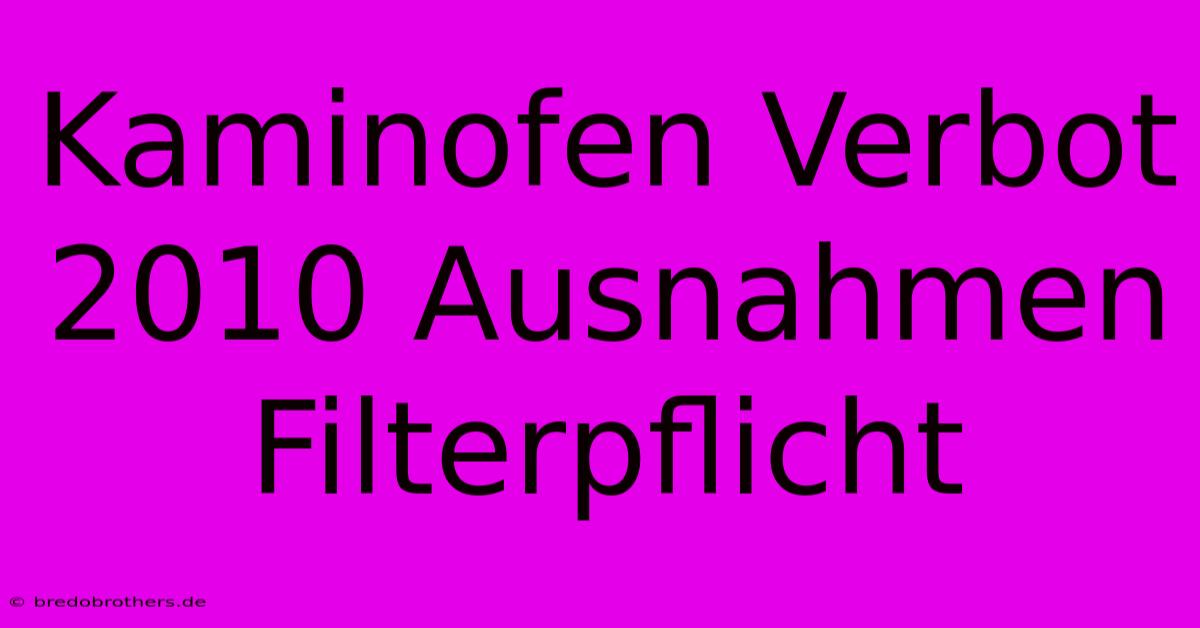Kaminofen Verbot 2010 Ausnahmen Filterpflicht

Discover more detailed and exciting information on our website. Click the link below to start your adventure: Visit Best Website Kaminofen Verbot 2010 Ausnahmen Filterpflicht. Don't miss out!
Table of Contents
Kaminofen Verbot 2010: Ausnahmen, Filterpflicht und was du jetzt wissen musst!
Hey Leute! Let's talk about something that's probably burned a hole (pun intended!) in a few people's pockets: the Kaminofen Verbot of 2010 and the whole shebang surrounding it. I mean, who didn't have a friend or relative freaking out about their beloved wood-burning stove? It was total chaos, right?
I remember back in 2009, my uncle, bless his heart, was so proud of his new, shiny Kaminofen. He’d spent a fortune on it, bragging about how cozy it made his house. Then BAM! The news hit – new regulations, potential bans, the whole nine yards. He was beside himself! It was a real rollercoaster.
Die 1. Verordnung zur Änderung der Ersten Bundes-Immissionsschutzverordnung (1. BImSchV)
The main issue was the 1. Verordnung zur Änderung der Ersten Bundes-Immissionsschutzverordnung (1. BImSchV). This regulation, which came into effect in stages starting in 2010, aimed to significantly reduce particulate matter emissions from wood-burning stoves. Think of it as a major crackdown on smoky chimneys. The goal? Cleaner air. A noble goal, for sure, but it certainly caused some headaches.
Many older Kaminöfen simply didn't meet the new emission standards. This meant they were either subject to restrictions on their use or, in some cases, faced outright bans. It was a nightmare for many homeowners who suddenly found their cozy winter companion becoming a potential source of legal trouble. My uncle? He was lucky. His stove, while not super modern, just squeaked by.
Ausnahmen vom Verbot: Was galt und was gilt heute?
So, what were the exceptions? That's where things get a little tricky. The specific details depended heavily on the Bundesland (federal state) and the local regulations. Some areas were stricter than others. The age of the stove was a factor; generally, newer stoves (those meeting the updated standards) were grandfathered in. But there was no single, easy answer. It was a massive logistical challenge, and for people who weren’t up to speed on the legal jargon, completely overwhelming.
Important: The regulations from 2010 have been updated and amended several times since. Don't rely on outdated information. Always check with your local Immissionsschutzbehörde (environmental protection authority) for the most current rules and regulations in your area. This is crucial!
Filterpflicht: Eine Lösung?
One common solution for those who wanted to keep their older stoves was to install particulate filters. These filters significantly reduced emissions, bringing many older models into compliance with the new standards. This, however, came with its own set of costs and considerations. The initial investment could be substantial, and regular maintenance was essential to ensure the filters continued to perform effectively. My uncle, for instance, had to shell out a pretty penny for a filter and regular cleaning.
Was du jetzt tun solltest:
- Check your stove's specifications: Find out what emission class your stove belongs to.
- Contact your local Immissionsschutzbehörde: Get the latest info on regulations and any potential exceptions.
- Consider a filter: If your stove doesn't meet the standards, a filter might be a viable option.
- Think long-term: If replacing your stove is on the cards, consider models that meet the latest emission standards, avoiding future headaches.
The 2010 Kaminofen Verbot was a complex issue, and navigating the regulations can be a minefield. But by being informed and proactive, you can avoid a lot of unnecessary stress and expense. Hopefully, this helps! Remember, staying up-to-date with local regulations is key. So, do your research!

Thank you for visiting our website wich cover about Kaminofen Verbot 2010 Ausnahmen Filterpflicht. We hope the information provided has been useful to you. Feel free to contact us if you have any questions or need further assistance. See you next time and dont miss to bookmark.
Featured Posts
-
Polizei Sucht Vermissten Klinik Favoriten Grosseinsatz
Nov 22, 2024
-
Frist Endet Kaminofen Tauschen 3112
Nov 22, 2024
-
Meinl Reisinger Legt Positionen Offen
Nov 22, 2024
-
Wicked Video Review Kritik Zum Film
Nov 22, 2024
-
Bitcoin 100k Anleger Sofort Reagieren
Nov 22, 2024
